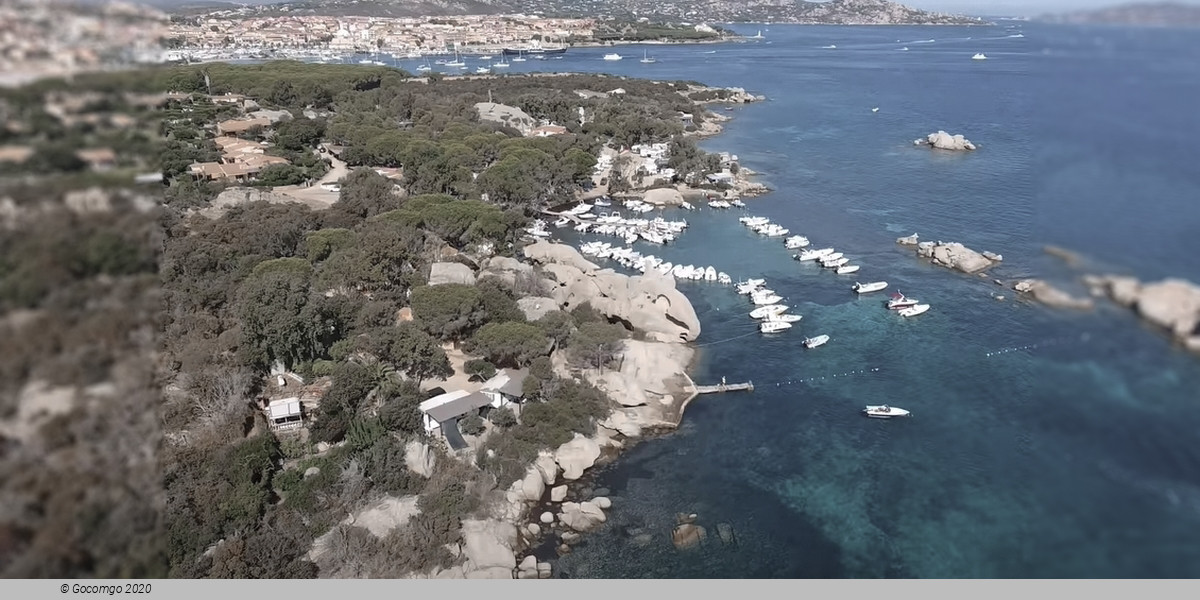Palau

Palau is a comune (municipality) in the Province of Sassari in the Italian region Sardinia, about 220 kilometers north of Cagliari and about 30 kilometers northwest of Olbia. It was a frazione of the comune of Tempio Pausania until 1959. It is located on Punta Sardegna and was founded in 1875 by local shepherds.
History
Prehistory and ancient history
In Palau, there are remarkable archaeological sites such as the Giant's Grave in Li Mizzani and Sajacciu, near the church of Saint Anthony of Gallura. The area of Li Mizzani is rich in prehistoric tombs, including a central stele 2.8 m high and 1.5 m wide. The area behind the stele and the exedra is made up of seven orthostatic plates, along a path covered in several lateral niches formed the tomb itself, and inside those niches, vases were found that served as containers for food and water. The formation has a peculiar layout similar to a bull's head (worshipped at the time) followed by underground tombs where they buried remains (previously skinned and disjointed) of important people, such as wizards and shamans, to whom a “funerary ceremony of the dying” was devoted, designed to help the person lose consciousness of time. These rites lasted five days, during which wizards stayed close to the dying, absorbing the curative and purifying magnetic energies emanated by the tomb. As early as Aristotle and Simplicius, from Tertullian to Filipono we find mention of these ancient Sardinian rites in their scripts.
Nearby Li Mizzani, there is the Luchìa nuraghe (thought to be an ancient Roman trade town), of which we can still see the basis and the remains of the prehistoric village situated in a strategic area where the whole land and the Strait of Bonifacio can be seen. Its ruins were raided in the '40s, like the Li Mizzani site, by a group of grave robbers looking for treasures. The Sajacciu tombs are not as known because of their bad state of preservation. Of the whole burial area, only two big horns and the upper part of the stele, adorned with three grooves of ritual origin, are left. The area was raided in 1918 to extract construction material for a nearby farmyard.
According to the Odyssey, during his troubled journey back home, Ulysses bumped into the Lestrigons, who was said to be living in the area of Palau itself and in its surroundings.
Modern and contemporary history
The name refers to the Catalan-Aragonese conquest of the 14th century (“palau” as in “palace”). The first mention of “Palau” can be found in the first Piedmontese land survey papers; the first town nucleus dates back to the first half of the 19th century, when the shepherds of “tempiesi” (from Tempio Pausaniaincluding the famous “Zecchinu”) that lived in the surrounding countryside moved to their seaside houses. They relocated temporarily to escape the torrid inner-land summer heat and gave life to the first families of the village, most of all to control their territories from a strategic point of view.
In 1793, there was a French attack during the war between the new Republic and the Kingdom of Sardinia. The very young lieutenant Bonaparte, who was trying to occupy the isle of La Maddalena, was rejected along with his fleet and forced to escape by the local sailors led by the Maddalenian Domenico Millelire, who had placed cannons on the Palau coast, and the Sardinian shepherds, who were stationed along the coast and struck the French ships light weaponry.
On the Isle of Saint Stephan, we can still find the house that young Bonaparte used as his base.
Gian Domenico Fresi-Zicchina built the first house in Palau in 1875. A major event was the bombing of the Italian Navy “Trieste” cruiser, which took place in the Mezzo Schifo (“Sciulara”) bay as a consequence of an Anglo-American bombing. The bay was half destroyed on 10 April 1943, causing more or less 100 deaths. The cruiser sank in the 17-meter-deep sea, and its relics were then retrieved and sold to Spain.
Palau remained a village of Tempio Pausania until 1959 when the autonomous municipality was established.

